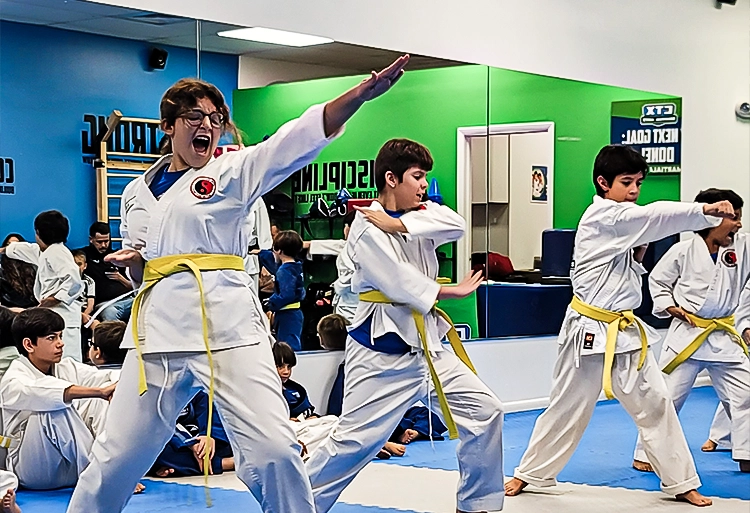
Stretching and Flexibility in Martial Arts
Strength combined with explosiveness is Power. It is made by rapidly releasing all of your muscular Power. Strength and speed must both be increased to increase Power. Utilizing both the muscle power and the momentum produced by the speed, you can exert strength while moving quickly.
Three techniques can be used to define Power:
- Explosive Power – The capacity to use the most force possible in one or a series of dynamic actions is known as explosive Power. For instance, punching a board till it breaks.
- Static Power– The most force that a person may temporarily exert is known as static Power. Consider the bench press.
- Dynamic Power – The capacity to consistently or repeatedly apply muscular force over time is known as dynamic Power. Using a heavy bag as an example.
Strength and quickness must both be increased in martial arts training to develop Power. Training in martial arts combines several practical principles. Knowing how to develop your muscles is crucial to martial arts training.
You can choose a martial arts system that fits your personal style of physical activity, whether your first introduction to martial arts was by viewing martial arts movies, reading martial arts periodicals, or watching martial arts instructional videos. Direct martial arts training or a collection of martial arts films that support the instruction you receive at the martial arts school are both effective ways for martial arts instructors to show you how to swiftly defeat an opponent.
The language of martial arts is evolving and growing more complicated and nuanced, much as languages change and dialects and accents represent various geographical or cultural locations on the earth.
As a result, a new martial arts form known as “mixed martial arts” has gained popularity. When individuals fight, those with knowledge of mixed martial artistry are able to communicate in a language that is widely recognized as a strong and skilled competitor, whether in competitions or on the street.
The choice of school is arguably the most significant decision a student will make about his or her martial arts training. Martial arts techniques and styles will vary from teacher to teacher and from school to school. Students’ health and safety are another concern of martial arts instructors. The skills that participants need to participate safely are taught to pupils by martial arts instructors at ctx martial art.
No matter where you live, who you are, or how old you are, martial arts training is now more accessible than ever at ctx martial art. You can frequently learn many martial arts disciplines at our training center. In addition, excellent high-tech martial arts equipment has been developed to satisfy the needs of martial artists, increasing performance and reducing the risk of harm.
Three Well-Known Strengthening Martial Arts Techniques
Punching and two distinct kicks are the techniques used at ctx martial art.
There are several reasons why people visit Ctx Martial Arts. Some people are drawn to martial arts because they desire to develop their self-defense skills. Others attend classes to benefit from martial arts’ immense potential as a tool for personal development. Others simply attend because they want to avoid the monotonous repetition and dullness of the gym and are searching for a fun, inspiring method to get in shape.
All of these things can be taught to a pupil through martial arts, but at their core, they are all forms of demanding physical exercise. Any Martial Art can be a great way to lose weight and get stronger, faster, more flexible, and leaner.
Strength Equals Power
This principle is applicable to all martial arts disciplines. Strengthening is one of the things we emphasize at ctx martial art. Although lifting weights is beneficial, a martial artist should avoid trying to acquire a body like a bodybuilder. The techniques themselves contain a large portion of the strength training that we perform at our CTX Martial Arts school.
Front Snap Kicks for Core Strength
The majority of kicks in martial arts use the leg muscles. However, many of the kicks we perform at ctx martial art also involve core muscles, like the abs and lower back. Therefore, it’s very effective to practice front snap kicks in the manner of Tae Kwon Do, with their high knee chambering, to develop your abs and your legs at the same time.
Gaining Upper Body Strength Through Punching
Strength in martial arts equals speed, and speed equals Power whenever it comes to strikes. I perceive a connection between the three. Therefore, punching will help you build stronger upper body muscles, while some weight exercises may assist you in boosting your punching power. Practicing punches on concentration pads, a heavy bag, or other ways are all strategies to improve upper body strength through martial arts.
Side Kicks for Lower Body Strength
One of a martial artist’s most powerful and swiftly acting weapons is the sidekick. Sidekicks use some of the same core muscles as a front snap kick. However, sidekicks put more of a physical strain on the lower body compared to many other Martial Arts kicks. Nevertheless, doing sidekicks is a wonderful approach to strengthening your legs, hips, and thighs. When you unleash a sidekick on a target, the effort you put into developing this strength via practice will pay off in the form of Power.
In case you got any concerns about how martial arts can help you acquire strength or anything else regarding our adult or children’s programs, don’t hesitate to contact the CTX Martial Arts staff.
Are you looking for a great martial arts school in your area? Find our locations below.
Address: 11782 SW 104th St, Miami, FL 33186 Or Call Number
